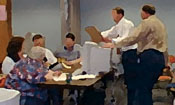

Chapter 12 - Research: Discovering What Works
All too often we re-invent the wheel, and then the wheel keeps on spinning. Even though a fortune is spent each year on educational research, we have considerable evidence that those who need to read the results of these studies rarely see them or heed them.Sadly, the bulk of educational research occurs at the university level and never manages to make it past the schoolhouse door. Attend the AERA (American Educational Research Association) convention and note how few school practitioners are there. Conversely, attend a convention of school administrators and note how few researchers are present.
School councils must break down these cultural and historical barriers to make certain that the insights from good educational research guide school improvement initiatives.
Some might claim that good educational research is an oxymoron. Eisner, once President of the AERA, criticized the typical educational research project for being focused upon trivial issues with too much concern about experimental design and not enough concern about critical learning questions. This phenomenon helps to explain why many school people may not bother reading the reports.
Does this justify planning in a vacuum? Certainly not. We can learn a great deal about school improvement by wading through the tales and stories of other practitioner who have tried various strategies. The narrative tradition may cast more light than the pseudo-scientific perspective which compels so many university researchers to gather data and crunch schools - as if they were numbers - into graphs and charts. A school council may learn more about turning around the performance of "at risk" students by reading the accounts of fellow travelers than they will learn by reading theoretical abstracts.
"But how can we be sure the new strategy will work? Our publics want proof in advance!"
The honest answer is that there are no guarantees in education because initiatives do not graft automatically onto the new school. Schools are complex social organizations with a tendency to reject transplants unless they are radically adjusted to fit local circumstances.
If the school council identifies a promising practice such as Success for All or Accelerate, Don't Remediate, visits to local sites and telephone interviews will quickly reveal that each site participating in these programs is quite unique. While there may be guiding principles and certain commonalities, there are far more differences than similarities. This means that simple imitation is not sufficient. Each school council must invent its own version, shifting, twisting, modifying and adapting the basic structure to take advantage of local situations and avoid local obstacles.
The purpose of this research phase, then, is to identify school programs which hold considerable promise to answer the school's essential planning questions. If the council wants to improve student reasoning, who has been successful at that task? What did they do to increase student success? Which of those stratgies are likely to match local conditions and local needs? Which seem alien and would need changing?
The research phase is a gathering process. Critique, analysis and synthesis are addressed in the next chapter on invention.
How does a school council open the window to the outside world without adding another 100 hours of library time to the already exhaustive time commitment associated with site-based management?
In the best of situations, central office performs a supportive, consulting role on behalf of the school councils. Staff properly trained in searching computer databases conducts ERIC searches targeted on the questions and issues being addressed by the school councils in the district. Unfortunately, many districts have no such research department or personnel and many who did have them are losing them because of budget problems and the belief that site-based management reduces the need for central office staff.
If this is the case, one member of the school council should be sent for training by one of the database companies like DIALOG so that searches can be conducted on a building level using a computer and modem.
An investment of less than several hundred dollars will help the group identify hundreds of success stories and failure stories worth reviewing. The online database provides a bibliography with abstracts that can help the group decide which articles are worth ordering and finding. Most can be ordered online from the database company. Others can be copied from journals in a university library. This collection allows the school council to travel across the nation (metaphorically) to visit other schools and learn from them.
A note of caution is important here. The stories written or told by school people tend to be long on triumph and short on trouble. Many of the articles are testimonials -- sales pitches for a particular school improvement strategy. Converts often speak in glowing tones about the innovation, erasing the difficulties and obstacles from the story. This does us all a disservice, obviously, because it leaves us ill-prepared and surprised when the innovation involves much more than we had expected. Members of the school council need to read all such stories with a sceptical eye.
Once the library is complete, the team must spend time reading and discussing. Which of these projects might fit our needs? How would we blend them with other good ideas we have encountered? How would we change them to fit our special situation. These questions lead naturally to the next chapter which explores the challenge of program invention.I
Copyrighted 1991 by Jamie McKenzie, all rights reserved.